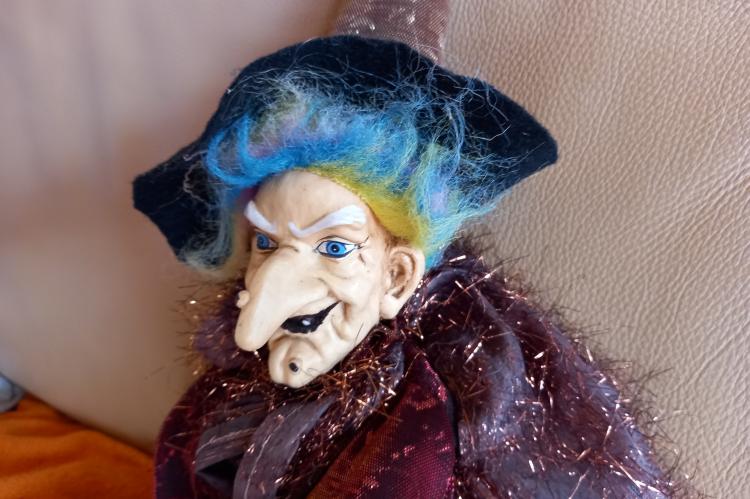Witch trials in the city of Cologne
Cologne had around 40,000 inhabitants in the 17th century. It was considered one of the largest cities in the "Holy Roman Empire of the German Nation". Approximately 2100 executions took place in the Electorate between 1446 and 1662. 90% of them were women. However, the intensity of the witch trials was not the same everywhere. In Vest Recklinghausen they were relatively small with around 100 victims. In Westphalia and the archbishopric on the left bank of the Rhine, on the other hand, the processes were very strong with 1,000 executed each.

The Elector Ferdinand von Wittelsbach
Under Elector Ferdinand von Wittelsbach most of the death sentences were carried out (1577 - 1650). He had undergone priestly training but was not ordained and initially worked as an administrator. During his reign, the persecution of witches was not only tolerated but promoted. The elector thus had a decisive share of responsibility for the accumulation of witch trials in those lands for which he was responsible. By contrast, there were comparatively few witch trials in the Free Imperial City of Cologne.
38 death sentences have been carried out in 216 years. This included 33 women, 3 men, a boy and a girl. 30 people were released. The highest number of executions took place between 1627 and 1630.
The shared jurisdiction
However, the divided jurisdiction ensured that the intensity of the persecution was not very high. In 1475, the Archbishop of Cologne lost sovereignty over his city. The jurisdiction was divided . He retained the sovereignty of the High World Court (HWG) and jurisdiction over capital crimes. This created competition between the instances. The jurisdiction of the City Council, the secular judges of the city (medium crime), the panel of secular judges of the High Secular Court (torture, judicial judgments, executions, etc.) and the interests of the archbishop were in fierce competition. With ten secular law graduates, the judges were subordinate to the Archbishop and the Electoral Court Council. The close relationship between all camps did not necessarily make the jurisdiction easier.
.jpg)
.jpg)
Which right was whom?
The city councils were allowed to carry out preliminary investigations and arrests, but not to use torture. The witchcraft crimes were also first investigated by the city councils. The victim was then passed on to the High Secular Court. The city councils made good use of their position and accused of witchcraft were rarely or very mildly punished. The councilor did not like that. During the time when witch trials occurred frequently, the lay judges of the HWG suddenly showed keen interest in the witch hunt. Some of them were Dr. Walram Blankenberg, Dr. Romeswinckel, Heinrich von Aldenhoven, Caspar Liblaer, Johann von der Dussel and Christian Schoenenberg. These were mostly PhD judges who had studied either law or theology. "Witch hunting" was also taught at the university.
In addition, theologians, for example in Ostermann or Glimbach, called for the denunciation of witches. Informer did not deserve it badly and thought they were doing humanity a favor. From 1620, so-called "witch commissioners" also served. The persecutors were protected. The victims were mostly "fair game" for their adversaries and people they just wanted to get rid of. The courts were ready to pursue any suspicions.
The Thirty Years' War (1618-1848) hadn't exactly improved the situation. Poor harvests, the plague, hunger and misery drove many to blacken others. This heralded the height of the witch hunt. The first two victims were Sophie Agnes von Langenberg, nun in the Cologne monastery of St. Klara and Katharina Henot. Both were executed as witches. Friedrich Spee knew the Henot family and used his knowledge in "Legal concerns against the witch trials".
Witnesses to witch trials
Friedrich Spee is still present today. There is a sculpture by him at Cologne City Hall. There is also the Friedrich-Spee-Haus and a commemorative plaque at the Jesuitenkirche St. Mariä-Himmelfahrt. Katharina Henot came from a wealthy patrician family in Cologne. Her mother was a Dutch noblewoman. Therefore, the family fled to Cologne during the uprising. The family was also very well respected. Some people did not like Katharina being respected, wealthy, and voicing her opinion. The witch trials came at just the right time. As a souvenir, there is also Katharina Henot Straße in Cologne.
.jpg)
What caused the sudden drop in witch trials in Cologne?
Almost all of the knowledge about the Cologne witch trials came from the pen of the court clerk Stephan Muser. One of the last executed was Katharina Plum. She found death, but previously named some theologians and judges in the witch trial that she would have seen at the witch's Sabbath. Thereupon there were surprisingly only five processes of this kind. The Aeltgen-Dünwald-Straße is named after the midwife Adeltgen Dünwald, who was one of the last executed.
The very last victim was the ten year old Lenart. She begged two younger brothers to survive. The father was shot and the mother lived with another man. "Straying" children were easy prey to the arbitrariness of the authorities. First the girl was thrown into the prison tower and accused of witchcraft. Although she willingly answered all questions, she had to wait two years in her prison before she was beheaded and burned.
Why were the witch trials so successful at first and what caused the change?
Accusing someone of witchcraft was a very efficient way of getting rid of that person forever . No matter whether it was a scorned lover, a competitor in the shop or a pretty rival. It was particularly bad when it came to children. Some were street children that nobody cared about. Others only served as a scapegoat or as a means to hit the parents. The poverty was great. Therefore, many wanted to earn something extra.
When Katharina Plum named several high-ranking personalities of the jurisdiction, it was ensured that no one could withdraw from the affair so easily. It was easy for a public figure to "do things". In the case of several, a flaw was more likely to remain. Multiple witnesses also meant multiple testimonies, which meant faster arrest and conviction. If someone was accused of witchcraft, it was almost impossible to get free. The more people were charged at the same time, the more they accused each other and testified against each other. And the last to be tried were the judges themselves.
The fear of being accused and convicted was too great after all.
Your visit to the cathedral city
Do you want to visit the cathedral city? You are exactly right with us! Rent a holiday apartment Cologne with a minimum occupancy of three nights. We look forward to your non-binding inquiry!






